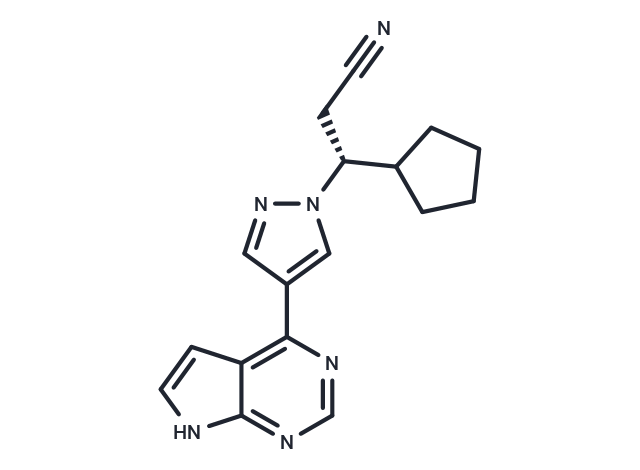购物车
- 全部删除
 您的购物车当前为空
您的购物车当前为空

Ruxolitinib (INCB018424) 是一种 JAK1/2 抑制剂 (IC50=3.3/2.8 nM),具有有效性和选择性。Ruxolitinib 具有抗肿瘤活性,可以诱导细胞自噬和凋亡。

Ruxolitinib (INCB018424) 是一种 JAK1/2 抑制剂 (IC50=3.3/2.8 nM),具有有效性和选择性。Ruxolitinib 具有抗肿瘤活性,可以诱导细胞自噬和凋亡。
| 规格 | 价格 | 库存 | 数量 |
|---|---|---|---|
| 1 mg | ¥ 233 | 现货 | |
| 5 mg | ¥ 536 | 现货 | |
| 10 mg | ¥ 828 | 现货 | |
| 25 mg | ¥ 1,530 | 现货 | |
| 50 mg | ¥ 2,320 | 现货 | |
| 100 mg | ¥ 3,730 | 现货 | |
| 200 mg | ¥ 4,990 | 现货 | |
| 500 mg | ¥ 7,690 | 现货 | |
| 1 mL x 10 mM (in DMSO) | ¥ 611 | 现货 |
| 产品描述 | Ruxolitinib (INCB018424) is a JAK1/2 inhibitor (IC50=3.3/2.8 nM) that is potent and selective. Rixolitinib exhibits antitumor activity and induces autophagy and apoptosis. |
| 靶点活性 | JAK2:2.8 nM (cell free), JAK1:3.3 nM (cell free), TYK2:19 nM (cell free) |
| 体外活性 | 方法:Ba/F3-EpoR-JAK2V617F 细胞用 Ruxolitinib (0-10 μM) 处理 48 h,使用 Cell-Titer Glo 检测的细胞活力。 结果:Ruxolitinib 剂量依赖性降低细胞活力,IC50 为 126 nM。[1] 方法:霍奇金淋巴瘤细胞 HDLM-2 用 Ruxolitinib (10-100 nM) 处理 24 h,使用 Western Blot 方法检测靶点蛋白表达水平。 结果:Ruxolitinib 显著抑制下游活性 p-STAT3 和 p-STAT5,且呈剂量依赖性,而总 STAT3 和 STAT5 水平保持不变。[2] |
| 体内活性 | 方法:为检测体内抗肿瘤活性,将 Ruxolitinib (3-30 mg/kg,5% dimethyl acetamide, 0.5% methocellulose) 灌胃给药给携带肿瘤 Ba/F3-JAK2V617F 的 BALB/c 小鼠,每天两次,持续三周。 结果:Ruxolitinib 显著降低了脾肿大和炎症细胞因子的循环水平,并优先消除了肿瘤细胞,从而显著延长了生存期,而没有骨髓抑制或免疫抑制作用。[1] 方法:为检测体内抗肿瘤活性,将 Ruxolitinib (150 mg/kg) 口服给药给携带人结直肠肿瘤 LS411N 的 BALB/c nude 小鼠,每两天一次,持续两周。 结果:口服 Ruxolitinib 可显著抑制人结直肠肿瘤的体内生长,而不会引起肝毒性。[3] |
| 激酶实验 | The kinase domains of human JAK1 (837-1142), JAK2 (828-1132), JAK3 (781-1124), and Tyk2 (873-1187) were cloned by PCR with N-terminal epitope tags. Recombinant proteins were expressed using Sf21 cells and baculovirus vectors and purified with affinity chromatography. JAK kinase assays used a homogeneous time-resolved fluorescence assay with the peptide substrate (-EQEDEPEGDYFEWLE). Each enzyme reaction was carried out with test compound or control, JAK enzyme, 500nM peptide, adenosine triphosphate (ATP; 1mM), and 2.0% dimethyl sulfoxide (DMSO) for 1 hour. The 50% inhibitory concentration (IC50) was calculated as the compound concentration required for inhibition of 50% of the fluorescent signal. Biochemical assays for CHK2 and c-MET enzymes were performed using standard conditions (Michaelis constant [Km] ATP) with recombinantly expressed catalytic domains from each protein and synthetic peptide substrates. An additional panel of kinase assays (Abl, Akt1, AurA, AurB, CDC2, CDK2, CDK4, CHK2, c-kit, c-Met, EGFR, EphB4, ERK1, ERK2, FLT-1, HER2, IGF1R, IKKα, IKKβ, JAK2, JAK3, JNK1, Lck, MEK1, p38α, p70S6K, PKA, PKCα, Src, and ZAP70) was performed using standard conditions using 200nM INCB018424. Significant inhibition was defined as more than or equal to 30% (average of duplicate assays) compared with control values [1]. |
| 细胞实验 | Cells were seeded at 2000/well of white bottom 96-well plates, treated with compounds from DMSO stocks (0.2% final DMSO concentration), and incubated for 48 hours at 37°C with 5% CO2. Viability was measured by cellular ATP determination using the Cell-Titer Glo luciferase reagent or viable cell counting. Values were transformed to percent inhibition relative to vehicle control, and IC50 curves were fitted according to nonlinear regression analysis of the data using PRISM GraphPad [1]. |
| 动物实验 | All of the procedures were conducted in accordance with the US Public Health Service Policy on Humane Care and Use of Laboratory Animals. Mice were fed standard rodent chow and provided with water ad libitum. Ba/F3-JAK2V617F cells (10^5 per mouse) were inoculated intravenously into 6- to 8-week-old female BALB/c mice. Survival was monitored daily, and moribund mice were humanely killed and considered deceased at time of death. Treatment with vehicle (5% dimethylacetamide, 0.5% methocellulose) or INCB018424 began within 24 hours of cell inoculation, twice daily by oral gavage. Hematologic parameters were measured using a Bayer Advia120 analyzed, and statistical significance was determined using Dunnett testing [1]. |
| 别名 | 鲁索替尼, 鲁索利替尼, 芦可替尼, INCB018424, (R)-Ruxolitinib |
| 分子量 | 306.36 |
| 分子式 | C17H18N6 |
| CAS No. | 941678-49-5 |
| Smiles | N#CC[C@H](C1CCCC1)n1cc(cn1)-c1ncnc2[nH]ccc12 |
| 密度 | 1.40g/cm3 |
| 存储 | store at low temperature | Powder: -20°C for 3 years | In solvent: -80°C for 1 year | Shipping with blue ice. | ||||||||||||||||||||
| 溶解度信息 | H2O: < 1 mg/mL (insoluble or slightly soluble) DMSO: 60 mg/mL (195.85 mM), Sonication is recommended. Ethanol: < 1 mg/mL (insoluble or slightly soluble) 10% DMSO+40% PEG300+5% Tween 80+45% Saline: 5.7 mg/mL (18.61 mM), In vivo: Please add the solvents sequentially, clarifying the solution as much as possible before adding the next one. Dissolve by heating and/or sonication if necessary. Working solution is recommended to be prepared and used immediately. | ||||||||||||||||||||
溶液配制表 | |||||||||||||||||||||
DMSO
| |||||||||||||||||||||
评论内容